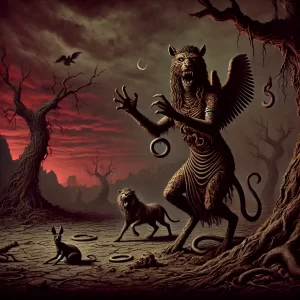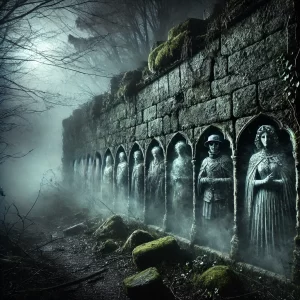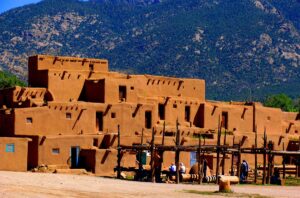In the heart of Japanese folklore, nestled within the dense, whispering forests, reside the enigmatic entities known as Kodama. These spirits, often associated with trees and natural habitats, have been the source of fascination, reverence, and cautionary tales for centuries. While to an outsider, they might merely seem like another facet of Japan’s rich tapestry of mythical creatures, to the locals, the Kodama are much more. They are the keepers of ancient stories, guardians of the forests, and symbols of the profound bond between nature and the human spirit. In today’s blog post, we will delve into the ethereal world of Kodama, tracing their origins, understanding their significance, and exploring the lessons they offer in our contemporary world. Join us on this journey as we unveil the mysteries of these forest spirits, a magical blend of myth, nature, and cultural reverence.
What is a Kodama?
The Kodama is a significant entity within Japanese mythology and Shinto beliefs. Let’s delve deeper into understanding the Kodama:
1. Origins and Mythology of the term
Kodama are spirits associated with trees, particularly ancient or sacred trees. The term “Kodama” can be broken down into “Ko,” meaning old, and “Dama” or “Tama,” signifying spirit or soul. Historically, they have been considered protectors of the forests, representing the animistic belief that every entity in nature has a spirit.
2. Appearance
The appearance of Kodama varies across stories and depictions. They are often invisible or appear as orbs of light. In other tales, they take on humanoid forms that are closely tied to the tree they inhabit, looking like ghostly figures. Some depictions even show them as trees with human features.
3. Dwellings
Kodama are primarily associated with trees, especially old and significant ones. It’s believed that cutting down a tree that houses a Kodama brings misfortune. For this reason, in many parts of Japan, significant trees, particularly ancient or oddly shaped ones, might have a sacred rope called a shimenawa tied around them, indicating their sanctity and warding off harm.
4. Behavior and Characteristics
Kodama are generally peaceful and protective, but they can become vengeful if their tree is harmed or disrespected. Legends say that those who harm a Kodama’s tree may face misfortune, illness, or even death.
They also have the ability to mimic sounds, and some stories suggest that if a traveler in the forest hears their own echo, it might be a Kodama mimicking them.
5. Cultural Significance
Kodama embody the deep respect and reverence that Japanese culture has traditionally held for nature. This reverence is especially evident in Shintoism, where natural entities, from rocks to waterfalls, are often believed to house spirits. The concept of Kodama underscores the idea that nature is alive, sentient, and deserving of respect.
6. Modern Depictions
Kodama have made appearances in various modern media. A popular depiction is in Hayao Miyazaki’s animated film “Princess Mononoke,” where they are represented as small, white humanoid figures with bobble-head-like movements, serving as guardians of the forest.
7. Environmental Lessons
The tale of the Kodama offers profound environmental lessons. The idea that harm befalls those who harm the trees is a direct commentary on the importance of living harmoniously with nature. It underscores the understanding that nature’s well-being directly impacts human well-being.
In summary, the Kodama are more than just mythical spirits; they are symbolic representations of the delicate balance between humans and the environment, serving as a reminder of the reverence and respect that nature commands.

How far back can the term Kodama be traced?
The concept of tree spirits is ancient and prevalent in many cultures, but when we specifically talk about the term “Kodama” in the Japanese context, its roots can be traced back at least to the Heian period (794-1185).
One of the earliest textual references to the Kodama can be found in the “Konjaku Monogatari,” a collection of over a thousand stories from the late Heian period. Here, the Kodama is depicted as a tree spirit capable of cursing or bringing harm to those who cut down its dwelling tree.
Another reference from the Heian period is the “Wamuryōrui Jōshō,” a Japanese dictionary from the 10th century. It describes the Kodama as spirits that cry out when a tree is about to be cut down, echoing the idea that these spirits protest and can bring harm when their trees are threatened.
The “Man’yōshū,” the oldest existing collection of Japanese poetry compiled sometime after 759 AD, also contains references that can be interpreted as describing the Kodama, indicating the longstanding cultural acknowledgment of these spirits.
Over time, as stories, beliefs, and regional customs merged and evolved, the Kodama took on a more definitive form in the collective Japanese consciousness, solidifying its role as a guardian of trees and forests.
It’s essential to understand that while specific terms or names might be relatively recent (in the span of a few centuries), the underlying concepts or beliefs about spirits in nature could be much older, having evolved over millennia and potentially pre-dating written records.
Where Can One “Seek” a Kodama?
Kodama are believed to dwell in ancient or sacred trees throughout Japan. While they are mythical spirits and therefore not physically observable in the conventional sense, there are certain forests and regions in Japan known for their deep spiritual significance and association with such folklore. If one were to “seek” a Kodama in its traditional habitat, the following forests and areas are of cultural and spiritual significance:
- Yakushima: Located in Kagoshima Prefecture, this ancient forest is a UNESCO World Heritage Site and is believed to have inspired Hayao Miyazaki’s animated film “Princess Mononoke,” which prominently features Kodama. The old-growth cedar trees, some of which are over a thousand years old, give the forest a magical and ancient feel.
- Aokigahara: Often called the Sea of Trees, this forest near Mount Fuji has a dense canopy and is known for its quiet, almost eerie atmosphere. While more infamously known for modern reasons, the forest has deep-rooted cultural and spiritual significance.
- Kii Mountains: These mountains are home to the Kumano Kodo pilgrimage routes, which have been used for over a thousand years. The forests along these routes, replete with ancient trees and shrines, are deeply spiritual and the kind of places where one could imagine spirits like the Kodama residing.
- Forests around Shrines: Many Shinto shrines in Japan are surrounded by forests, which are considered sacred grounds. Trees within these groves, especially ancient or oddly-shaped ones, may be marked with shimenawa (sacred ropes), indicating that they are believed to house spirits like the Kodama.
While these are some notable forests and regions associated with deep spiritual significance, it’s essential to approach them with respect and understanding. The belief in Kodama reflects the Japanese reverence for nature, emphasizing harmony with the environment and understanding the deep ties between humans and the natural world.
Are there other spirits like a Kodama?
Yes, many cultures around the world harbor beliefs in spirits associated with nature, especially trees and forests. Here are a few spirits that share similarities with the Kodama:
- Yoruba Religion – Orisha: The Yoruba religion, native to West Africa, particularly Nigeria, believes in various spirits known as Orisha. Some of these spirits are associated with natural elements, including trees, rivers, and winds.
- Norse Mythology – Yggdrasil and Landvættir: While Yggdrasil is the World Tree connecting the nine worlds in Norse mythology, the landvættir are land spirits or guardians. Trees and stones often represent them, and they are believed to protect and influence the prosperity of the land.
- Celtic Beliefs – Dryads and Green Man: Dryads are tree spirits or nymphs in ancient Greek beliefs, but similar spirits are present in Celtic traditions. The Green Man, often depicted as a face formed from leaves and vines, is another iconic representation in European folklore, symbolizing the spirit of the forest.
- Native American Beliefs: Many Native American tribes have spirits associated with natural elements, including trees, rivers, and animals. These spirits are integral to the tribe’s cultural practices and belief systems.
- Philippine Mythology – Diwata: The Diwata are spirits or deities associated with nature in Philippine folklore. Some of them reside in large trees, mountains, or caves, similar to the Kodama’s association with significant trees.
- Baltic Mythology – Laima: Laima is a fate deity who is sometimes associated with trees in Baltic mythology. Trees, especially the sacred oak, are integral to various rituals and beliefs in this region.
- Slavic Mythology – Leshy: The Leshy is a forest spirit, often depicted as a tall man resembling a tree. He is the guardian of the animals, and he can lead travelers astray, making them lost in the forest.
- Hawaiian Beliefs – Menehune: While not exactly tree spirits, Menehune are believed to be a dwarf-like people or spirits in Hawaiian mythology, responsible for building various structures overnight. They are associated with the hidden parts of the islands, forests, and valleys.
While each culture has its nuances and stories surrounding these spirits, the common thread is the deep connection and reverence for nature. Such spirits often serve as guardians, protectors, or even avatars of nature’s wrath, emphasizing the importance of living in harmony with the environment.

What do I do if I see a Kodama?
Encountering a Kodama is more a matter of spiritual or folkloric belief than a tangible experience in the modern world. However, the lore surrounding these spirits offers guidance on how to behave should one believe they have come into contact with a Kodama.
- Show Respect: The foremost rule is to show reverence. Kodama are protective spirits of trees, especially ancient and significant ones. If you believe you’ve come across such a tree or the spirit of Kodama, bowing or acknowledging its presence is a traditional sign of respect.
- Do Not Harm the Tree: Legend has it that those who harm a tree housing a Kodama may face misfortune, illness, or even death. If a tree gives you a sense of spiritual significance or is marked with shimenawa (sacred rope), avoid cutting, damaging, or otherwise harming it.
- Listen Carefully: Kodama are sometimes believed to mimic sounds or voices. If you hear your voice echoing unusually in a forest, it might be seen as a sign of a nearby Kodama. While scientifically this is just an echo, in folklore, it’s a gentle reminder of the Kodama’s presence.
- Offer a Small Token: In some traditions, leaving a small offering, like a coin or food, can be a gesture of goodwill. While not specifically tied to Kodama, it’s a common practice for spirits in many cultures.
- Move Away Quietly: If you believe you’ve encountered a Kodama, once you’ve acknowledged its presence, it’s best to move away quietly and without causing disruption. This reflects a general respect for nature.
- Share Stories, Not Locations: If you genuinely feel you’ve encountered a spiritually significant spot or tree, it’s often better to share your story without revealing the exact location. This prevents the site from becoming a tourist spot, which might disrupt its serenity and spiritual significance.
- Educate Yourself: If you’re in an area known for its spiritual significance, educate yourself on local customs, beliefs, and traditions. Respecting local practices can help preserve the cultural integrity of the location and ensure you’re behaving appropriately.
Remember, beliefs in entities like Kodama vary widely, and while they are an integral part of Japanese folklore, not everyone in Japan might take them literally. However, the lessons they teach about respecting nature and understanding the interconnectedness of life are universally valuable.

















































Leave a Reply